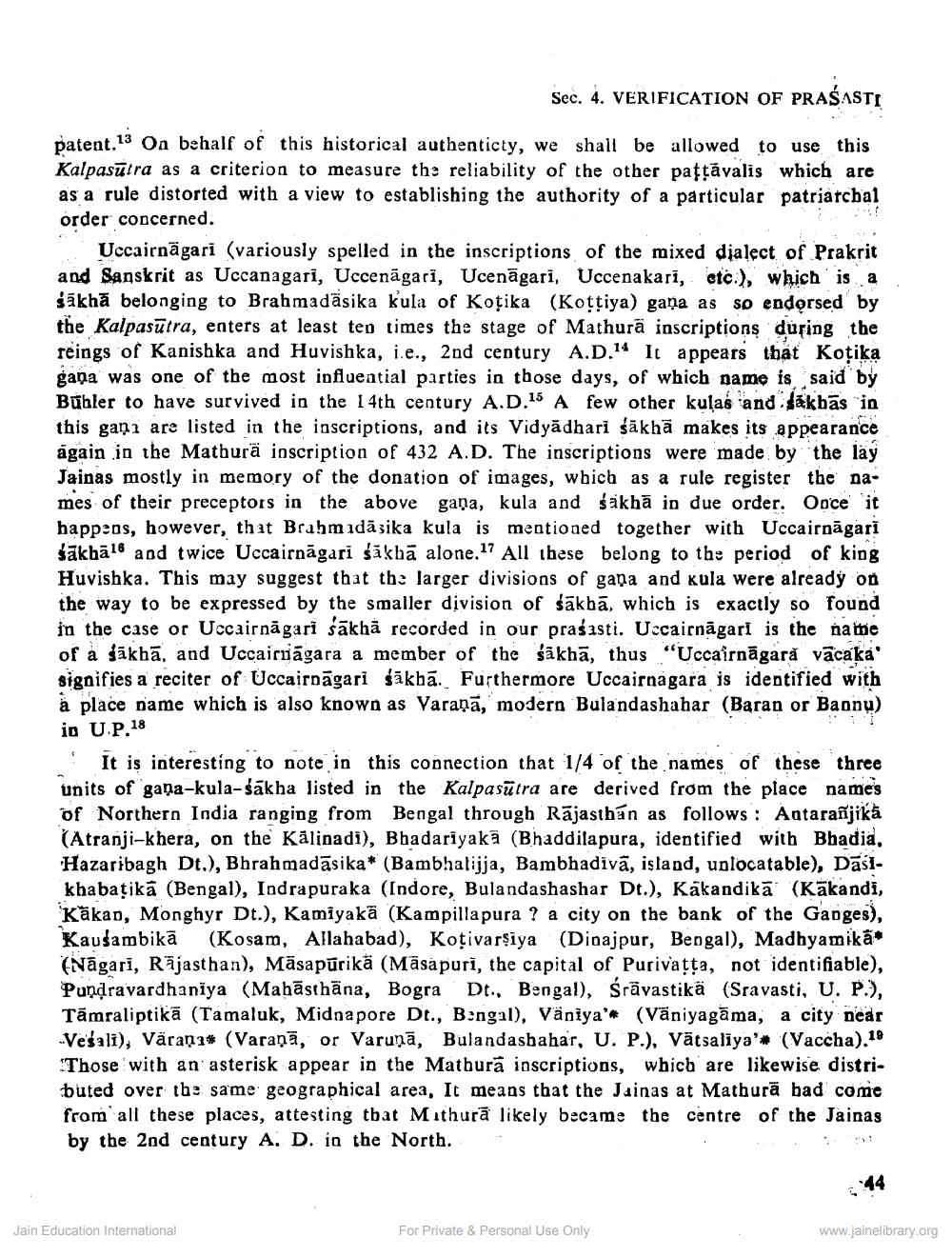________________
Sec. 4. VERIFICATION OF PRASASTI
patent.13 On behalf of this historical authenticty, we shall be allowed to use this Kalpasūtra as a criterion to measure the reliability of the other pattavalis which are as a rule distorted with a view to establishing the authority of a particular patriarchal order concerned.
Uccairnagari (variously spelled in the inscriptions of the mixed dialect of Prakrit and Sanskrit as Uccanagari, Uccenāgari, Ucenāgari, Uccenakari, etc.), which is a sakha belonging to Brahmadäsika kula of Kotika (Kottiya) gana as so endorsed by the Kalpasūtra, enters at least ten times the stage of Mathura inscriptions during the reings of Kanishka and Huvishka, i.e., 2nd century A.D.14 It appears that Kotika gana was one of the most influential parties in those days, of which name is said by Bühler to have survived in the 14th century A.D.15 A few other kulas and khas in this gap are listed in the inscriptions, and its Vidyadhari sākhā makes its appearance again in the Mathura inscription of 432 A.D. The inscriptions were made by the lay Jainas mostly in memory of the donation of images, which as a rule register the names of their preceptors in the above gapa, kula and akha in due order. Once it happens, however, that Brahmidasika kula is mentioned together with Uccairnagari śākhā1 and twice Uccairnagari sikha alone." All these belong to the period of king Huvishka. This may suggest that the larger divisions of gapa and kula were already on the way to be expressed by the smaller division of sakba. which is exactly so found in the case or Uccairnagari fakha recorded in our prasasti. Uccairnagart is the name of a fakha, and Uccairnagara a member of the kha, thus "Uccairnagara vācaka' signifies a reciter of Uccairnagari fakha. Furthermore Uccairnagara is identified with a place name which is also known as Varana, modern Bulandashahar (Baran or Bannu) in U.P.18
It is interesting to note in this connection that 1/4 of the names of these three units of gana-kula-sakha listed in the Kalpasūtra are derived from the place names of Northern India ranging from Bengal through Rajasthan as follows: Antarañjikā (Atranji-khera, on the Kälinadi), Bhadariyaka (Bhaddilapura, identified with Bhadia. Hazaribagh Dt.), Bhrahmadasika (Bambhalijja, Bambhadiva, island, unlocatable), Dasikhabatika (Bengal), Indrapuraka (Indore, Bulandashashar Dt.), Kakandikā (Kākandi, Kakan, Monghyr Dt.), Kamiyaka (Kampillapura ? a city on the bank of the Ganges), Kausambika (Kosam, Allahabad), Kotivarsiya (Dinajpur, Bengal), Madhyamikā (Nagari, Rajasthan), Māsapūrikä (Māsapuri, the capital of Purivatta, not identifiable), Pundravardhaniya (Maḥāsthāna, Bogra Dt., Bengal), Śrāvastikä (Sravasti, U. P.), Tāmraliptikā (Tamaluk, Midnapore Dt., Bengal), Väniya' (Väniyagama, a city near -Veil), Varanas (Varap, or Varuna, Bulandashahar, U. P.), Vätsaliya' (Vaccha).1 Those with an asterisk appear in the Mathura inscriptions, which are likewise distributed over the same geographical area, It means that the Jainas at Mathura had come from all these places, attesting that Mathura likely became the centre of the Jainas by the 2nd century A. D. in the North.
Jain Education International
For Private & Personal Use Only
-44
www.jainelibrary.org




